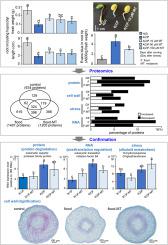Journal of Proteomics ( IF 2.8 ) Pub Date : 2020-12-01 , DOI: 10.1016/j.jprot.2020.104064 Xin Wang 1 , Fang Li 1 , Zhenyuan Chen 1 , Bingxian Yang 2 , Setsuko Komatsu 3 , Shunli Zhou 1

|
Flooding constrains soybean growth, while melatonin enhances the ability of plants to tolerate abiotic stresses. To interpret the melatonin-mediated flooding response in soybeans, proteomic analysis was performed in root tips. Retarded growth and severe cell death were observed in flooded soybeans, but these phenotypes were ameliorated by melatonin treatment. A total of 634, 1401, and 1205 proteins were identified under control, flood, and flood plus melatonin conditions, respectively; and these proteins were predominantly associated with metabolism of protein, RNA, and the cell wall. Among these melatonin-induced proteins, eukaryotic aspartyl protease family protein was increased after flood compared with melatonin treatment group, in accordance with its upregulated transcript levels during stress. Eukaryotic translation initiation factor 5A was decreased after flood compared with melatonin. When stress was prolonged, its transcript levels were upregulated by flood, while they were not changed by melatonin. Furthermore, 13-hydroxylupanine O-tigloyltransferase was decreased by flood compared with melatonin; however, its transcription was upregulated by melatonin. In addition, reduced lignification in root tips of flooded soybeans was restored by melatonin. These results suggest that factors related to protein degradation and functional states of RNA play critical roles in promoting the effects of melatonin on soybean plants under flooding.
Significance
Flooding stress threatens soybean growth, while melatonin treatment enhances plant tolerance to stress stimuli. To examine the effects of melatonin on flooded soybeans, morphological analysis was performed. Melatonin promoted soybean growth as judged from greater fresh weight of plant, longer seedling length, and less evident cell death in flooding-stressed soybeans treated with melatonin than those plants exposed to flood alone. Proteomic analysis was conducted to explore promoting effects of melatonin on soybeans under flooding stress. As a result, metabolism of protein metabolism, RNA regulation, and the cell wall was enriched by proteins identified under control, flood, and flood plus melatonin conditions. Among these melatonin-induced proteins, abundance of eukaryotic aspartyl protease family protein, eukaryotic translation initiation factor 5A, and 13-hydroxylupanine O-tigloyltransferase displayed similar change patterns between the control and melatonin compared with flood; and transcript levels of genes encoding these proteins responded to flooding stress and melatonin treatment. In addition, activated cell degradation, expanded intercellular spaces, and reduced lignification in root tips of flooded soybeans were ameliorated by melatonin treatment.
中文翻译:

蛋白质组学分析揭示了褪黑激素对洪水胁迫下大豆根尖的影响
洪水限制了大豆的生长,而褪黑激素则增强了植物耐受非生物胁迫的能力。为了解释大豆褪黑素介导的淹水反应,在根尖进行了蛋白质组分析。在水淹大豆中观察到生长迟缓和严重的细胞死亡,但这些表型通过褪黑激素处理得到改善。在对照、洪水和洪水加褪黑激素条件下分别鉴定出总共 634、1401 和 1205 个蛋白质;这些蛋白质主要与蛋白质、RNA 和细胞壁的代谢有关。在这些褪黑激素诱导的蛋白质中,与褪黑激素处理组相比,真核天冬氨酰蛋白酶家族蛋白在洪水后增加,与其在应激期间上调的转录水平一致。与褪黑激素相比,洪水后真核翻译起始因子 5A 减少。当压力持续较长时,其转录水平会因洪水而上调,而褪黑激素则不会改变它们。此外,与褪黑激素相比,13-羟基羽扇豆碱O-替格酰基转移酶因洪水而降低;然而,其转录被褪黑激素上调。此外,褪黑激素可以恢复淹水大豆根尖木质化的减少。这些结果表明,与蛋白质降解和 RNA 功能状态相关的因素在促进褪黑激素对洪水条件下大豆植物的影响方面发挥着关键作用。
意义
洪水胁迫威胁大豆生长,而褪黑素处理增强植物对胁迫刺激的耐受性。为了检查褪黑激素对淹水大豆的影响,进行了形态学分析。从与单独暴露于洪水的植物相比,用褪黑激素处理的洪水胁迫大豆中植物的鲜重更大、幼苗长度更长以及细胞死亡更不明显来判断,褪黑激素促进了大豆生长。通过蛋白质组学分析探讨褪黑素对洪水胁迫下大豆的促进作用。结果,蛋白质代谢、RNA 调节和细胞壁的代谢因在对照、泛滥和泛滥加褪黑激素条件下鉴定的蛋白质而丰富。在这些褪黑激素诱导的蛋白质中,与洪水相比,真核天冬氨酰蛋白酶家族蛋白、真核翻译起始因子5A和13-羟基羽扇豆碱O-替格酰基转移酶的丰度在对照和褪黑激素之间表现出相似的变化模式;编码这些蛋白质的基因的转录水平对洪水胁迫和褪黑激素治疗有反应。此外,褪黑素处理可改善淹水大豆根尖的激活细胞降解、扩大细胞间隙和减少木质化。











































 京公网安备 11010802027423号
京公网安备 11010802027423号